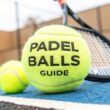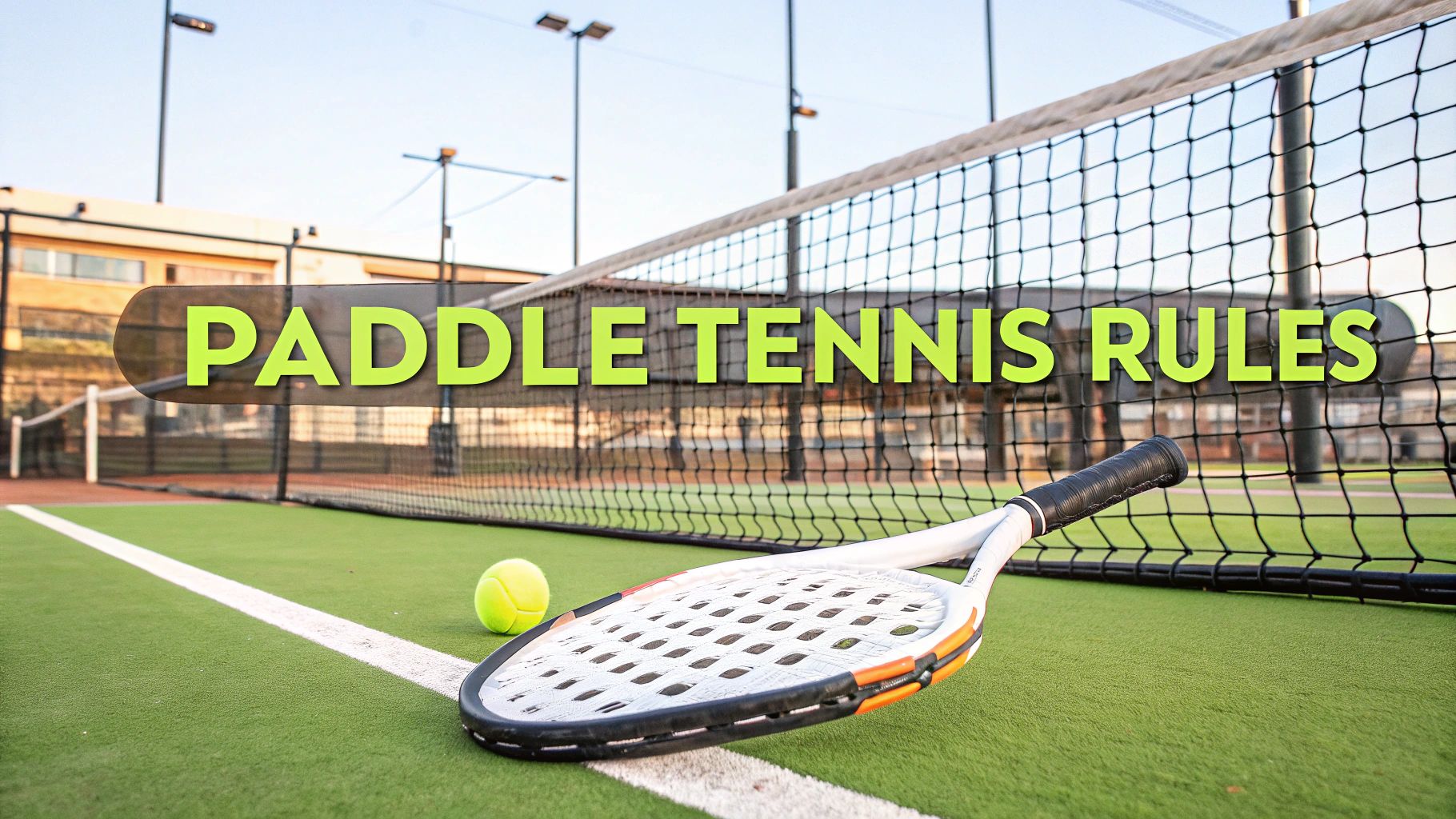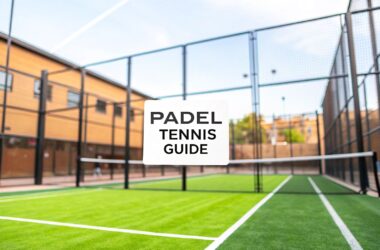At its heart, paddle tennis (or padel, as it's more commonly known) is wonderfully simple. You serve underhand, you let the ball bounce once before hitting it, and you do your best to keep it inside the glass-enclosed court. The scoring is identical to tennis, and you win by taking sets. It's this beautiful, accessible blend of tennis and squash that gets people hooked.
Understanding the Fundamentals of Paddle Tennis
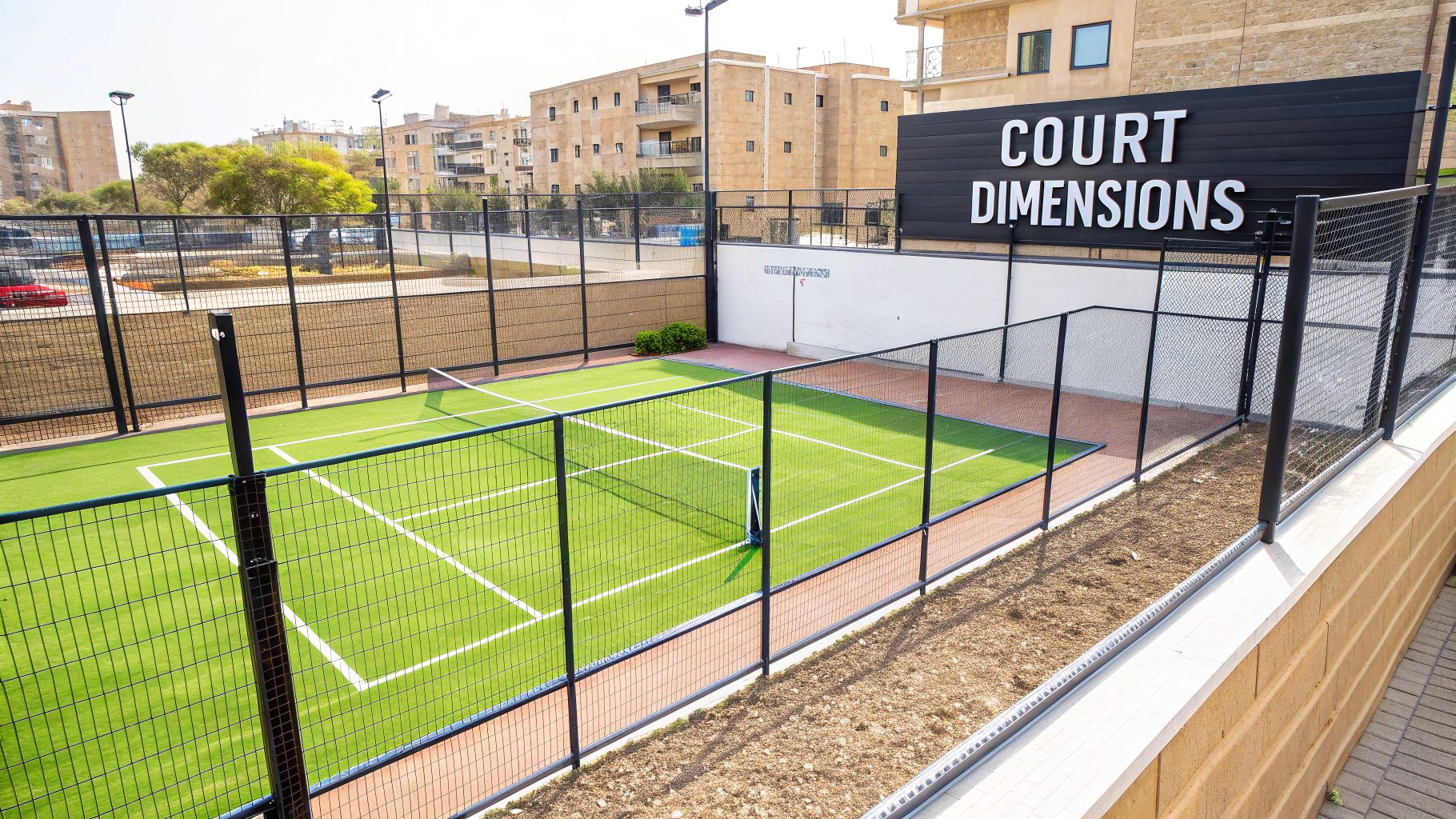
So, you're ready to jump into the exciting world of padel? Awesome. It's a game that mixes the fast-paced volleys of tennis with the clever, strategic wall-play of squash. Before we get into all the nitty-gritty rules, let's just get a feel for the game's flow. The easiest way to picture it is as "tennis in a box." Those walls aren't just boundaries; they're an active, exciting part of every single point.
Your main goal is pretty straightforward: get the ball over the net in a way that your opponents can't legally hit it back. You'll win the point if they hit the ball into the net, knock it completely out of the court, or let it bounce twice on their side. Simple enough, right? But the real magic—and what makes padel so unique—is how you can use the glass and mesh walls to your advantage.
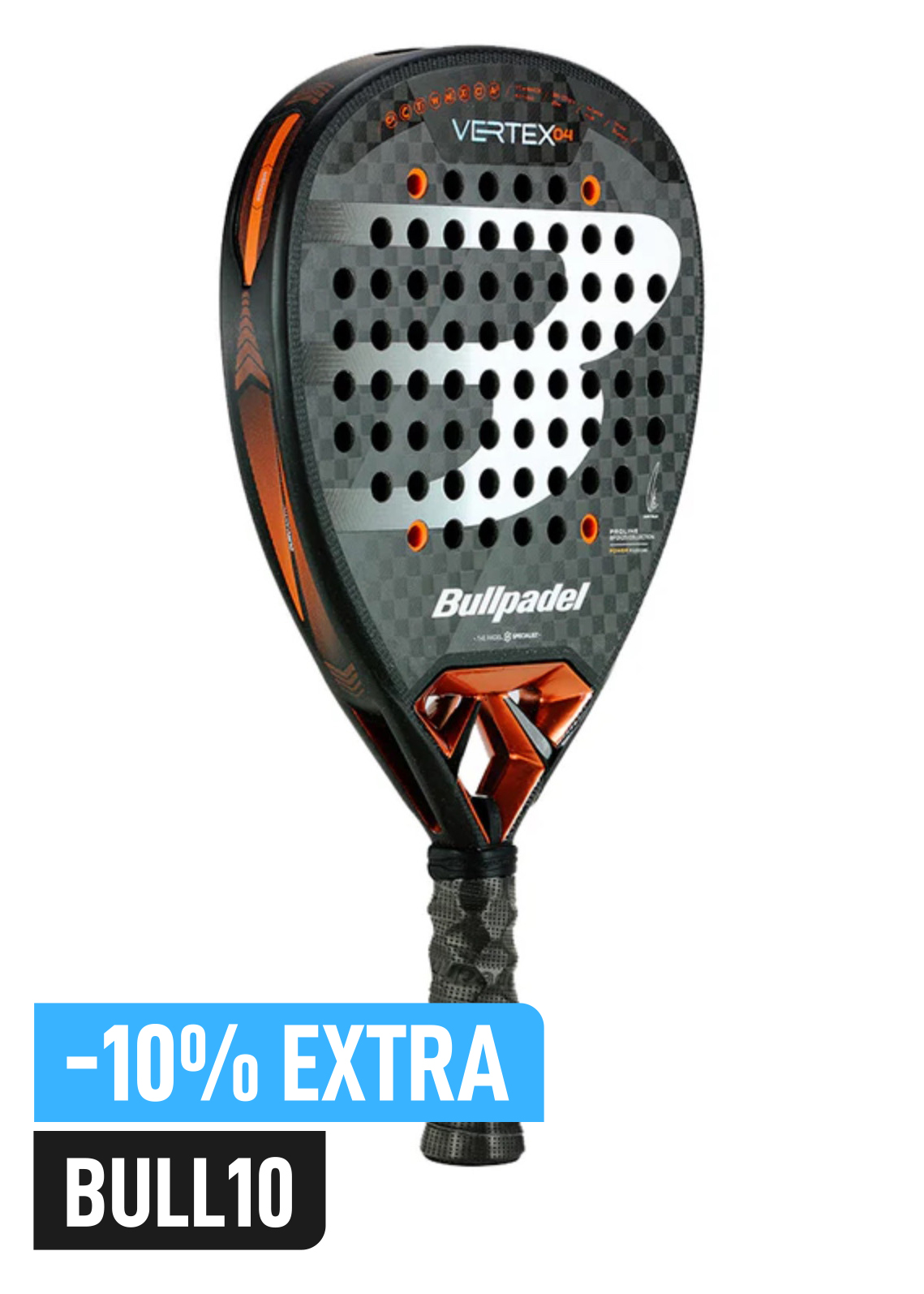
Buy the best padel gear to level up your next game!
CHECK OUT this deal from Padel Market!Get ready to take your game to the next level with the latest padel gear from Padel Market! Fast EU and Worldwide Shipping
Key Concepts for Beginners
If you can grasp just a few core ideas, you'll have a huge head start on the court. First off, forget everything you know about powerful tennis serves. In padel, serves are always underhand, which makes getting the point started much less intimidating for new players.
The rallies are where things get really interesting. They tend to last longer and feel more dynamic because you can legally play the ball after it has bounced off the back or side walls. This single rule changes everything. It adds a whole new layer of strategy that rewards smart positioning and anticipation just as much as raw power.
This unique mix of rules didn't just appear out of nowhere. Padel was actually invented back in 1969 in Acapulco, Mexico. A man named Enrique Corcuera decided to modify his home squash court to create a new game for his friends and family. He’s the one who established the standard doubles court dimensions of 10 by 20 meters (that's about 33 by 66 feet), creating a hybrid sport that truly captured the best parts of its predecessors. You can learn more about the game's fascinating journey and history on padelandtennis.co.uk.
The biggest mental shift for new players is learning to see the walls as an ally, not an obstacle. Instead of signaling the end of a point, a well-placed rebound off that back glass can become the perfect setup for your winning return.
Paddle Tennis (Padel) Rules at a Glance
To help you get into your first game without getting bogged down in details, we've put together a quick cheat sheet. Think of this table as the absolute essentials you need to know.
Here's a quick summary of the most important rules for a new player.
| Rule Category | Key Specification | Brief Explanation |
|---|---|---|
| The Serve | Underhand, at or below waist level. | You must drop the ball and hit it after it bounces once, aiming diagonally into your opponent's service box. |
| Scoring | Same as tennis: 15, 30, 40, Deuce. | A game is won by scoring four points with a two-point lead. Six games win a set. |
| Wall Play | Walls can be used after the ball bounces. | The ball must hit the ground on your opponent's side first before it hits a wall. A shot that goes directly into a wall is a fault. |
| The Paddle | Solid, stringless, and perforated. | The solid paddle gives you a ton of control and has a very different feel compared to a traditional stringed tennis racket. |
With these basics under your belt, you're more than ready to step onto the court and start having some fun. The finer points will come with practice
Before you can really get into the rules of paddle tennis, you have to get a feel for the arena. The court isn't just a patch of turf; it's an active player in the game, shaping every single shot and strategy you can think of. The same goes for the equipment—it’s all designed to give padel its unique pace and feel.
Think of a padel court as a strategic glass box. The playing area itself is 10 meters wide by 20 meters long, but it’s the walls that completely define the game. These aren't just boundaries; they can be your best friends. The back walls are usually tempered glass, and the sides are a mix of glass and wire mesh. This combo creates predictable, lively bounces that smart players use to flip a defensive scramble into a winning attack.
The Anatomy of the Padel Court
The court's layout is what dictates the game's rhythm. You've got the net splitting the court down the middle and the service lines creating the boxes you need to aim for on a serve. But the history of these dimensions is actually pretty interesting, showing just how practical the sport's origins were.
Take its cousin, platform tennis. That sport's court size was born out of pure necessity. Back in the fall of 1928, some neighbors built a wooden platform that was exactly 48 feet long by 20 feet wide. Why those numbers? Because the bumpy terrain couldn't handle anything wider without a ton of work. You can read more about how these simple decisions shaped a whole sport in the Platform Tennis Hall of Fame's history of the game.
The main takeaway is that every part of the court—from the 88 cm net height in the middle to the materials on the walls—is engineered for that fast, strategic gameplay that makes padel so addictive.
Choosing Your Tools: The Paddle and Ball
Once you've got the court figured out, it's time to gear up. The paddle and ball are the only two things you need, but the rules around them are super important for keeping the game fair and fun.
The padel paddle, or "pala," is a whole different beast from a tennis racket. It’s solid, has no strings, and is covered in holes to cut down on weight and air resistance. This design gives you a great mix of power and control, which is perfect for the smaller court and constant wall action. Paddles have to stick to official size rules and must have a wrist strap—that part's mandatory to keep paddles from flying around and hurting someone.
The ball is also a little different. It might look just like a regular tennis ball, but it has slightly less pressure inside. It’s a small change, but it makes a huge difference, resulting in a lower, more controllable bounce. This gives players more time to react and sets up longer rallies, especially when you're playing shots off the walls. Using the wrong ball can totally mess with the speed and feel of the game. If you're new to the sport, getting the equipment right is a big first step, and our complete guide on how to play paddle covers more of these fundamentals.
Executing a Legal Serve and Return
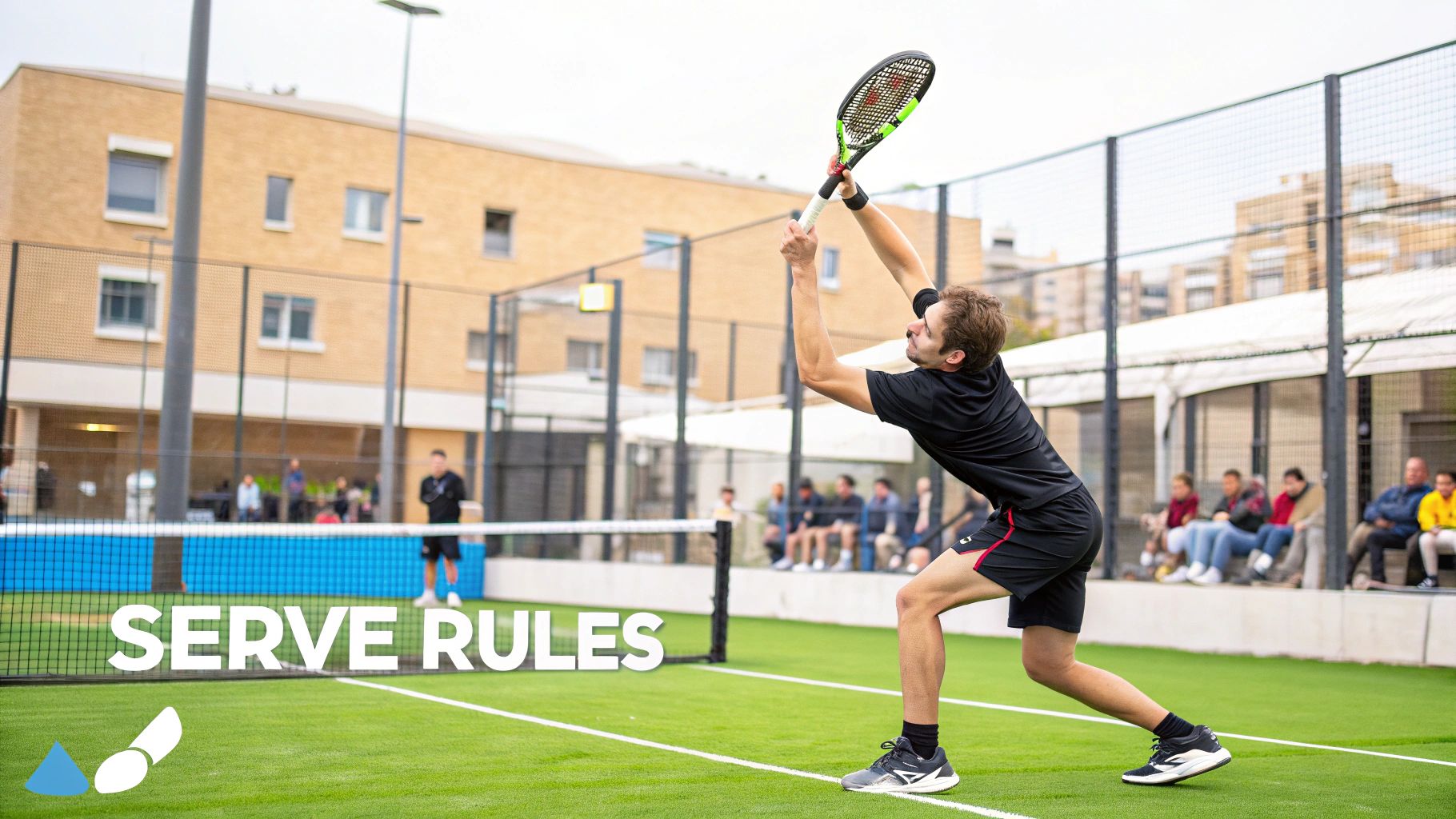

Buy the best padel gear to level up your next game!
CHECK OUT this deal from Padel Market!Get ready to take your game to the next level with the latest padel gear from Padel Market! Fast EU and Worldwide Shipping
Every single point in padel kicks off with a serve, making it without a doubt the most critical shot to get right. But if you're coming from tennis, forget about those explosive, overhead aces. The rules for paddle tennis bring things back down to earth with a mandatory underhand motion. This simple tweak levels the playing field, shifting the focus from raw power to pure strategy right from the get-go.
Think about it: the serve is the one moment in the game where you have absolute control. Mastering the mechanics isn't about blasting the ball; it's about precision, consistency, and starting every point on your own terms. Getting this right is the difference between giving away cheap points on faults and immediately putting your opponents on the back foot.
Mastering the Underhand Serve
The soul of the padel serve is that it's always underhand. It's less of a weapon and more like a handshake that starts the rally. The rules are super specific here, designed to keep the serve from becoming an overly aggressive attack.
To pull off a legal serve, just follow this simple sequence:
- Stand Behind the Line: Both feet need to be completely behind the service line as you start your motion.
- Bounce the Ball: You have to let the ball bounce once on your side of the court, also behind the service line.
- Strike Below the Waist: This is the big one. Your paddle must make contact with the ball at or below your waist level. This rule is what prevents players from smashing the ball downwards with too much pace.
- Aim Diagonally: Your serve has to fly across the net and land in the service box that’s diagonally opposite you.
The ball must land cleanly inside that box. Hitting the wire mesh fence on the fly is a fault, but it is allowed to hit the glass wall after it bounces. If your serve nicks the net and then drops into the correct box, that’s called a let. No harm, no foul—you just play the serve again.
A classic beginner mistake is hitting the ball without bouncing it first or making contact way up by the chest. A great mental trick is to think of your belly button as the absolute ceiling for your contact point. It's a simple way to stay legal.
Avoiding the Dreaded Foot Fault
The foot fault is one of those picky rules that can drive players crazy, and it's a hot topic of debate on the court. It’s an instant lost serve, so knowing exactly where your feet can and can't be is essential for building a consistent serve.
The rule itself is straightforward: a server's foot can't touch or cross the baseline before the paddle makes contact with the ball. You can swing your foot over the line in your follow-through, but it can’t touch the court until after the ball is gone.
The Art of the Return
Once a legal serve is in play, it’s the receiving team's turn to hit a legal return. The rules here are much simpler, but a good return still demands quick reflexes and smart court positioning.
The receiver must let the ball bounce one time in the service box before hitting it back. You can't just step in and volley the serve out of the air. After that initial bounce, though, things get interesting. You can either play the ball directly back over the net or let it bounce off the glass walls first before you make your shot.
This is where the strategy of the return really opens up. For a closer look at all the technical details, you can dive into our guide on the official padel serve rules. Nailing the serve and return is the foundation of every single point you'll play.
How to Keep Score and Win the Match
If you’ve ever watched or played tennis, you’re already halfway there. Paddle tennis borrows its scoring system directly from its older cousin, which is great news for beginners. The familiar flow of points, games, and sets makes it easy to jump in and follow the action.
Think of it like building blocks. You win points to get a game. You win games to get a set. And you win sets to take the match. It’s a simple ladder to victory, but understanding the details is what separates the rookies from the regulars.
From a Single Point to a Full Game
Every game kicks off at zero, which in the quirky world of racquet sports is called “Love.” From there, the scoring is probably something you've heard before:
- First point won: 15
- Second point won: 30
- Third point won: 40
- Fourth point won: Game
To win a game, your team needs to score at least four points and, crucially, be ahead by at least two. So, if you rattle off four points in a row, the score ticks up from Love to 15, then 30, 40, and finally, game over. But things get spicy if the score gets tied at 40-40.
This 40-40 deadlock is famously known as “Deuce.” At this point, you have to win two straight points to clinch the game. Win the first point after Deuce, and your team has the “Advantage.” If you win the very next point, the game is yours. Lose it, and the score snaps right back to Deuce. This back-and-forth can continue until one team finally manages to string those two crucial points together.
The Modern Twist: The Golden Point
While the classic Deuce-Advantage system creates some nail-biting moments, a newer rule has popped up to keep matches moving, especially in the pro circuits. To speed things up, some events introduced the "golden point" rule at deuce starting in 2020.
Here’s how it works: instead of playing out the Advantage, the game comes down to one single, sudden-death point. The receiving team gets to choose which side of the court (left or right) they want to receive the serve from. Whoever wins that one rally wins the entire game. It’s a fast, dramatic way to break a tie. To learn more about how the sport has changed over the years, check out this great piece on the evolution of padel on padelandtennis.co.uk.
Before you start a match, it’s always a good idea to clarify with your opponents whether you’re playing with the traditional Advantage rule or using the Golden Point.
This image breaks down some of the most common ways to lose a point.
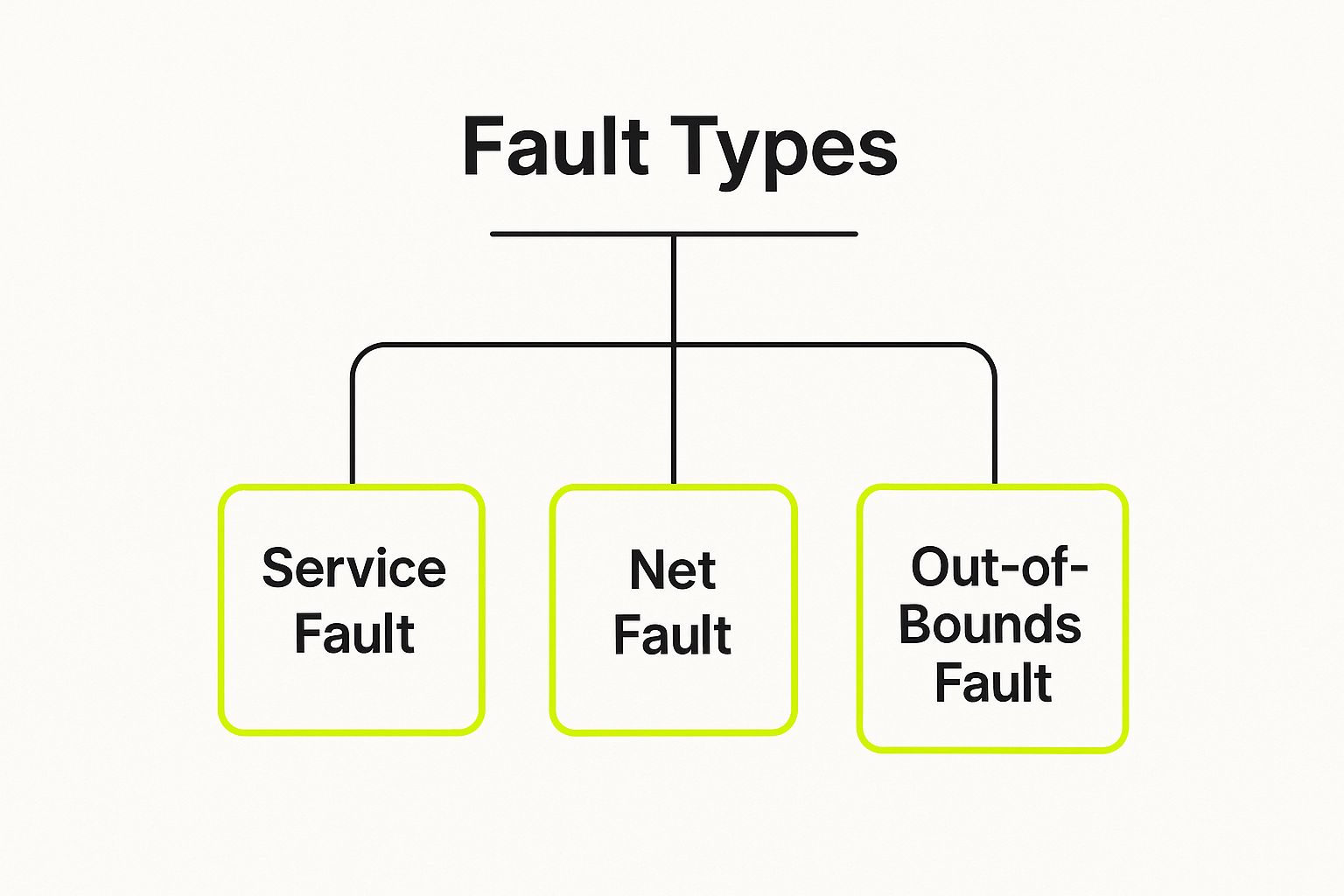
As you can see, simple mistakes like a bad serve, touching the net, or hitting the ball out of bounds will instantly cost you the point.
Winning Sets and Sealing the Match
Once you’ve won a game, the next target is the set. A set is won by the first team to win six games, but just like with points, there’s a catch: you have to win by a margin of at least two games. That means a 6-4 or 6-3 scoreline seals the deal.
If the score gets to 6-5, the leading team has one more chance to win the next game and close out the set 7-5. But if the score gets knotted up at 6-6, it’s time for a tie-break.
A standard tie-break is a race to seven points. The first team to score seven points wins, but (you guessed it) they must win by two. The winner of the tie-break takes the set with a final score of 7-6.
Most paddle tennis matches are played as the best of three sets. It’s simple: the first team to win two sets walks off the court as the winner.
For a quick reference, here’s how all the scoring elements build on each other to get you to that final victory handshake.
Winning a Paddle Tennis Match Step-by-Step
| Scoring Unit | How to Win It | Key Notes |
|---|---|---|
| Point | Opponent fails to return the ball legally. | The smallest unit of scoring. |
| Game | Be the first to win 4 points (by a margin of 2). | Scored as 15, 30, 40, Game. A 40-40 tie is called Deuce. |
| Set | Be the first to win 6 games (by a margin of 2). | If the score reaches 6-6, a tie-break is played to decide the set. |
| Match | Be the first to win 2 sets (in a best-of-three match). | The ultimate goal. Winning two sets secures the overall victory. |
Ultimately, knowing how the score works isn't just about keeping track—it's about understanding the rhythm of the match and knowing exactly what you need to do to win.
Common Faults and Rules of Play
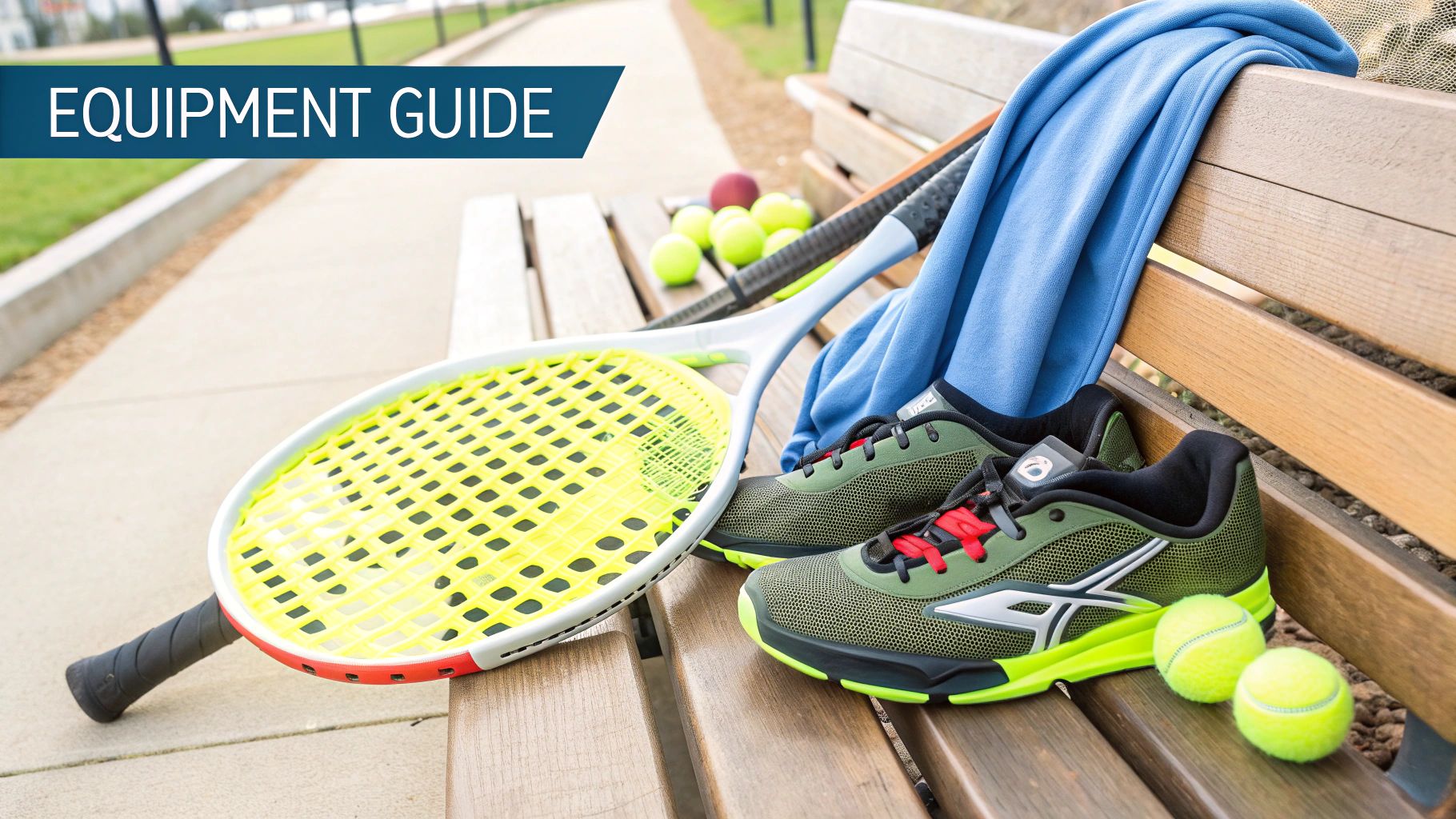
Knowing the rules of padel isn't just about what you can do—it's just as much about what you can't. A fault is any misstep that hands a point, a game, or even the whole match to your opponents. Getting a handle on these rules means you can play with more confidence, cut down on simple mistakes, and navigate any tricky on-court situation like a seasoned pro.
In padel, a fault is simply any action that breaks the rules and costs you the point. Many are pretty straightforward, like hitting the ball into the net or smashing it completely out of the court. But the game's unique, enclosed court creates some really interesting scenarios that every player needs to understand to truly get the game.
Defining Common On-Court Faults
Let's break down the most frequent ways a rally ends. If you do any of these things, the point is immediately over, and your opponents get the score.
- The Double Bounce: If the ball bounces twice on your side before you hit it back, you lose the point. This is all about quick reflexes.
- Net Infractions: Hitting the ball straight into the net is the most basic fault. But also, if your paddle, clothes, or any part of your body touches the net or its posts while the ball is live, you automatically lose the point.
- Hitting the Ball Twice: You only get one shot to return the ball. Hitting it twice, even by accident, is a fault.
- Ball Hits a Player: If the ball hits you or your partner anywhere on the body before you can return it with your paddle, the point goes to the other team.
Mastering these fundamentals is the first real step toward building a consistent, reliable game.
Here's the most critical sequence to burn into your memory: the ball must always hit the ground on your opponent’s side before it can legally touch any of the surrounding walls or fence. A direct shot into the wall is always a fault.
The Intricacies of Wall and Fence Play
This is where padel really shows its unique character. The walls aren't just boundaries; they are an active part of the game, and they have specific rules that can trip up newcomers. It's essential to understand how this works, especially since the playing surface can be surrounded by 4-meter-high walls of glass or brick, making for some wild strategic rebounds.
Here are the key wall-play scenarios you need to know:
- Legal Rebounds: After the ball bounces once on your opponent's side, they can let it rebound off any of the glass walls before they hit their return. This is a massive part of padel strategy.
- Illegal Fence Contact: If your shot hits the ground on your opponent's side and then hits the wire mesh fence, it's a fault. You lose the point. The ball has to be played before it touches that fence.
- Direct Wall Hit (Fault): Hitting the ball directly into any of your opponent’s walls or the fence before it bounces on the ground is a fault. No exceptions.
Learning how to use the glass to your advantage while steering clear of that dreaded fence is a skill that only comes with practice.
Understanding the Concept of a Let
Every now and then, a point needs a do-over. In padel, this is called a "let," and it just means the point is replayed with no penalty to either side. It's the game's built-in way of handling unexpected interruptions or certain technical situations.
The most common let you'll see is on a serve. If a serve clips the net cord but still lands legally in the correct service box, it’s a let, and the server gets to replay that specific serve. However, if that same serve hits the net and lands out, it's a fault. A let can also be called if something from outside the court interferes with play, like a stray ball from another court rolling on. This keeps things fair and stops points from being decided by random chance.
For a much deeper dive into all these scenarios, you can check out the complete guide to the official rules of paddle tennis.
Padel Rules: Your Questions Answered
Even after you get the hang of the basics, some situations on the court can still make you second-guess yourself. The unique rules of padel, especially those involving the walls and net, often spark a bit of friendly debate between points. This section cuts through the confusion and gives you clear, direct answers to the most common questions.
Think of this as your go-to guide for those tricky "what if" moments that always seem to pop up during a heated rally. Getting these scenarios straight won't just improve your game; it'll make you the go-to rules expert in your group.
Can the Ball Hit the Fence Before It Bounces?
This is a big one, and the answer is a firm no. The ball has to hit the ground on your opponent's side first. If your shot sails directly into the metal fence on their side without bouncing, that’s a fault. You lose the point on the spot.
What really matters is the sequence. Once the ball has legally bounced on the ground, it can then rebound off the glass walls or even the fence and still be in play. The key is that the ground always comes first.
The easiest way to lock this rule in your head is with a simple mantra: "Ground, then wall." Any other order is a fault. This little phrase clears up one of the biggest points of confusion for new players.
What Is the Double Bounce Rule in Padel?
The double bounce rule is as simple as it sounds. If the ball bounces twice on your side of the court before you manage to hit it back, you lose the point. This applies to every single shot in the game, from the return of serve to the longest rallies.
This rule is what gives the game its incredible pace. It forces quick reflexes, smart court positioning, and good communication with your partner. Your goal is always to get to the ball after a single bounce, at most.
Can I Reach Over the Net to Hit the Ball?
Generally, you can't reach over the net to hit the ball on your opponent's side. The actual point of contact with the ball has to happen on your side of the court. But, there's a key exception to this: the follow-through.
After you've legally hit the ball on your side, your paddle is allowed to cross over the plane of the net as part of your natural swing. The critical part is that you already made contact on your side.
It's also super important to remember that if your paddle, body, or even your clothes touch the net while the ball is live, you lose the point immediately. No exceptions.
What Happens if the Ball Hits Me or My Partner?
If the ball hits you or your doubles partner at any point before it bounces, your team loses the point. It doesn't matter where you're standing—up at the net or back by the glass.
The ball can only ever be played with the paddle. This rule really highlights how important it is to move and communicate with your partner, especially in a fast-paced doubles game. You've got to work together to control the court and avoid those costly, accidental touches.
At Padel Rumors, we're all about helping you master every part of the game, from understanding the rules to finding the perfect gear. Check out our expert guides, racket reviews, and tournament news to take your game to the next level. Visit us at https://padelrumors.pages.dev and join a global community of padel lovers.


